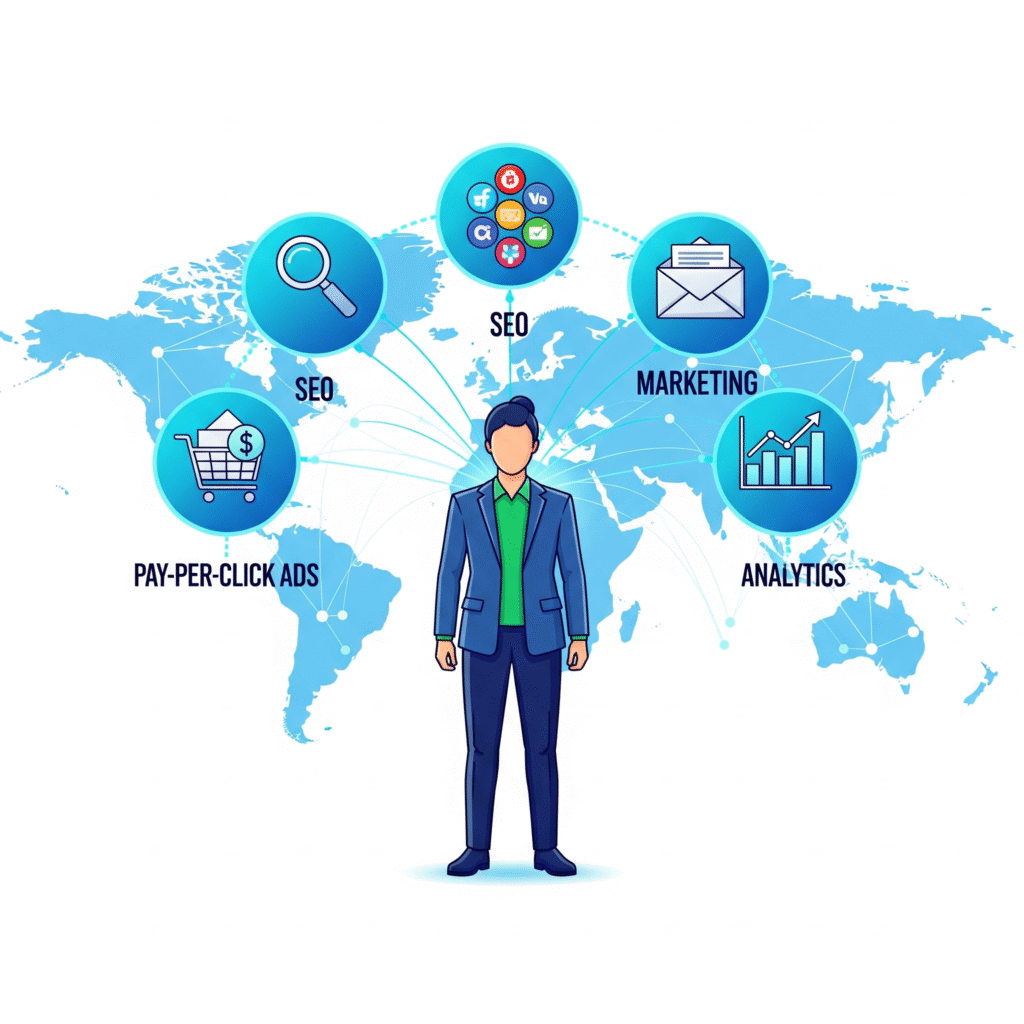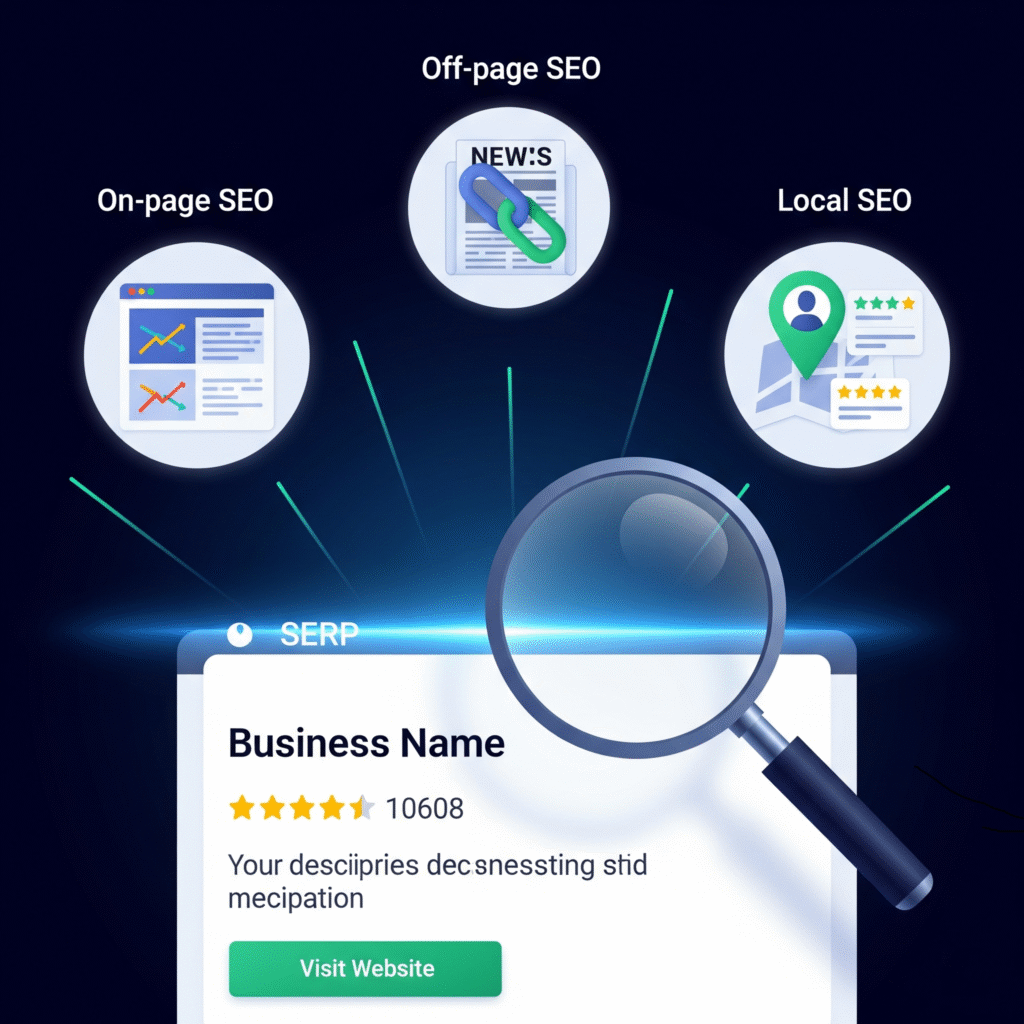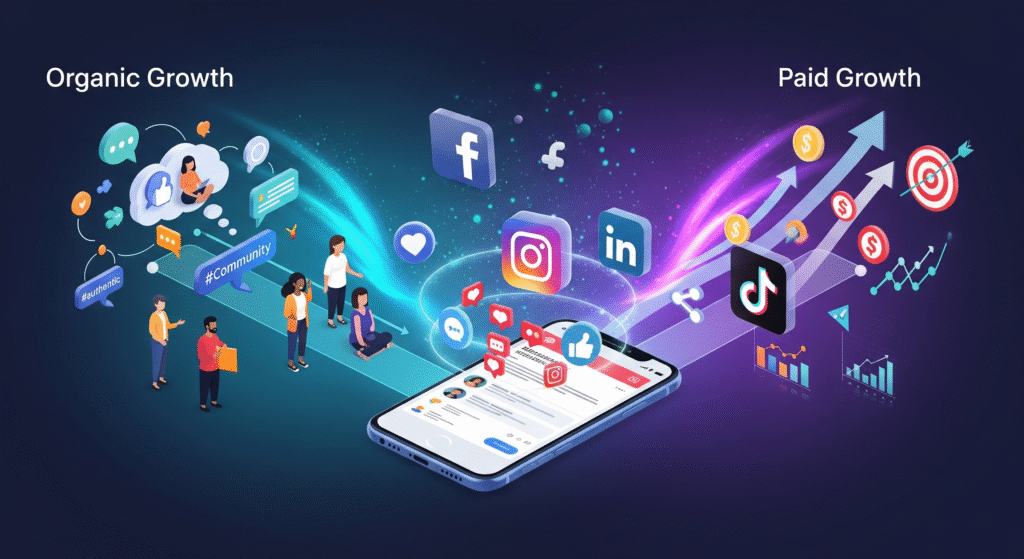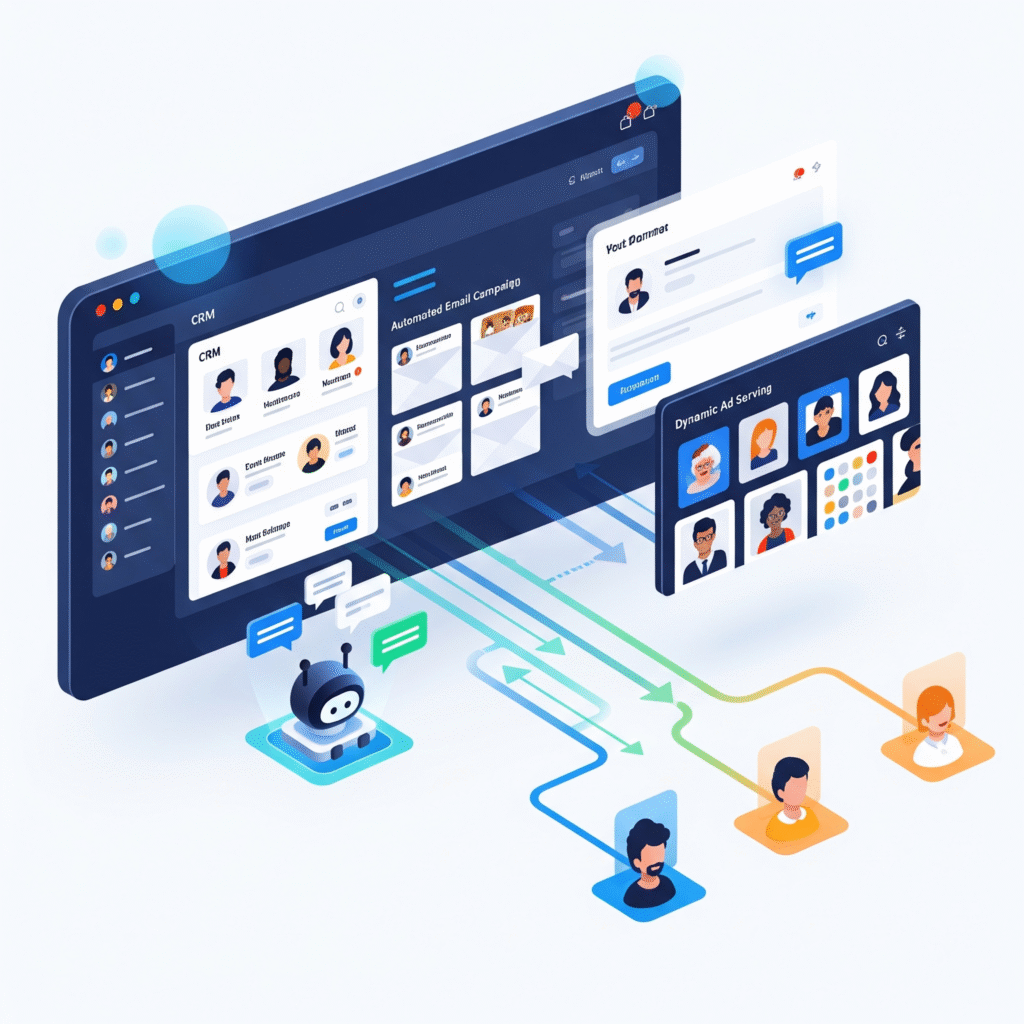Why do some businesses thrive online while others fade into obscurity? The answer often lies in digital marketing. In today’s fast paced marketplace, having a strong digital presence is no longer optional, it’s essential.
Digital marketing gives businesses the tools to reach more customers, build trust, and compete on a global scale. In fact, HubSpot reports that over 60% of marketers say digital channels generate the highest-quality leads. That’s proof that ignoring digital marketing means missing out on growth opportunities.
At its core, digital marketing is the most cost-effective way to scale a business, whether you’re a startup or a large enterprise. This guide will show you how to harness its power step by step and boost your business with strategies that actually work.
What Is Digital Marketing?
What does it really mean when we talk about digital marketing? At its core, digital marketing is the use of online channels such as search engines, social media, email, and websites to promote a business and connect with potential customers.
Unlike traditional marketing, which relies on tools like billboards, print ads, or TV commercials, digital marketing takes place where people now spend most of their time online. While traditional methods cast a wide net with limited targeting, digital marketing allows businesses to reach specific audiences with precision and measurable results.
This shift matters because the modern customer journey begins long before a purchase. Consumers research products on Google, compare brands on social media, and read reviews before deciding who to trust. A strong digital presence ensures that your business shows up at every step of that journey, guiding prospects toward becoming loyal customers.
Now that we understand what digital marketing is, let’s explore why it has become the driving force behind business growth in today’s economy.
Why Digital Marketing Matters for Business Growth
How do some businesses manage to attract customers far beyond their local reach while others struggle to get noticed? The answer often lies in the power of digital marketing. It allows companies to expand their presence beyond geographic boundaries and connect with a highly targeted audience that is already interested in what they offer.
Unlike traditional advertising, which can be costly and uncertain, digital marketing is remarkably cost-effective.

A small business can run a focused social media ad campaign for a fraction of what a print or TV ad would cost, all while reaching people who are more likely to convert.
Another key advantage is measurability. With tools like Google Analytics and social media insights, businesses can track clicks, conversions, and customer behavior in real time. These insights make it easier to refine strategies, reduce wasted spending, and maximize return on investment.
Most importantly, digital marketing builds authority and trust. Consistently sharing valuable content, engaging with audiences, and appearing in search results positions your brand as credible. Over time, this trust translates into loyalty and loyal customers are the backbone of sustainable growth.
With these benefits in mind, the next step is to look at the core strategies that make digital marketing such a powerful driver of business success.
Core Strategies to Boost Your Business with Digital Marketing
Search Engine Optimization (SEO)

Have you ever asked yourself why some businesses consistently show up on Google’s first page while others remain buried in the search results? The difference is often in how effectively they use Search Engine Optimization (SEO). Done right, SEO makes your business discoverable to the very people searching for your products or services.
On-page SEO focuses on what’s within your control of your website.
This includes optimizing content with the right keywords, crafting clear titles and meta descriptions, and structuring your site so both users and search engines can navigate it easily. Strong on-page SEO ensures your website speaks the same language as your audience.
Off-page SEO, on the other hand, is all about building authority beyond your website. Backlinks from reputable sources act as votes of confidence, signaling to search engines that your brand is trustworthy. Guest posts, digital PR, and strategic partnerships all help strengthen this credibility.
For businesses serving local customers, Local SEO is a game changer. Optimizing your Google Business Profile, encouraging customer reviews, and targeting location based keywords ensures that when someone nearby searches for your service, your business shows up first.
Together, these three aspects of SEO create a powerful foundation that drives visibility, traffic, and growth. But ranking higher is only the beginning; the real challenge lies in keeping your audience engaged.
Content Marketing
What makes people stop scrolling and notice your business? More often than not, it’s content that speaks directly to their needs. Content marketing is the practice of creating blogs, videos, infographics, and podcasts that inform, inspire, and engage.
Valuable content does more than fill space; it attracts the right audience. A blog post can answer a pressing question, while a video tutorial can show how your product solves a problem. By offering consistent value, you guide prospects from interest to conversion.
Facts alone aren’t enough. Storytelling gives your content emotional impact. Sharing customer success stories, your brand’s journey, or the “why” behind what you do builds authenticity. When people connect with your story, they trust your brand and trust drives loyalty.
With great content in place, the next step is to share it where your audience already spends time.
Social Media Marketing
Why do some brands dominate your feed while others go unnoticed? The secret is smart social media marketing. Platforms like Facebook, Instagram, LinkedIn, and TikTok give businesses a direct line to billions of users, each with unique ways to connect and engage.
There are two main paths to growth: organic and paid. Organic growth comes from posting valuable content, using hashtags, and engaging with followers. Paid ads, on the other hand, allow you to target specific audiences with precision, driving faster results and higher conversions.

But success isn’t just about likes or clicks it’s about building community. By responding to comments, creating conversations, and showing authenticity, you turn followers into advocates. A strong community doesn’t just buy from you; they spread your message and fuel long-term growth.
With a loyal social audience, the next step is keeping the conversation alive through personalized follow-ups. That’s where email marketing makes its mark.
Email Marketing
How do you turn a curious visitor into a loyal customer? One of the most reliable ways is through email marketing. Unlike social media, where algorithms decide who sees your content, email gives you direct access to your audience’s inbox.
Lead nurturing sequences play a key role here. By sending a series of helpful and timely emails, you guide prospects step by step from awareness to decision without overwhelming them. Each message builds trust and keeps your brand top of mind.
Personalization makes these campaigns even more effective. By segmenting your list based on interests, behavior, or demographics, you can send messages that feel tailor made. A personalized subject line or a product suggestion can dramatically increase open and conversion rates.
The results speak for themselves. According to industry studies, email marketing delivers an average ROI of $36 for every $1 spent. Businesses that use segmented and targeted campaigns see even higher returns, proving email remains one of the most powerful tools for growth.
Once your emails are driving steady engagement, you can amplify results further with pay per click (PPC) advertising.
Pay-Per-Click (PPC) Advertising
Ever wondered how some businesses appear at the very top of Google the moment you search for a product? That’s the power of pay-per-click advertising. Platforms like Google Ads and Meta Ads (Facebook and Instagram) allow you to put your brand in front of the right people at the right time.
PPC isn’t just about visibility, it’s about targeting. Through retargeting campaigns, you can re-engage people who visited your site but didn’t convert. This gentle reminder often makes the difference between a lost opportunity and a loyal customer.
The real strength of PPC lies in speed. Unlike organic strategies that take time to build, PPC delivers instant results. With the right targeting and budget, it can generate traffic, leads, and sales within days, making it one of the fastest ways to accelerate business growth.
Once paid ads bring new customers in, partnerships with influencers and affiliates can expand your reach even further.
Influencer & Affiliate Marketing
Why do people trust a product more when it’s recommended by someone they admire? That’s the essence of influencer and affiliate marketing leveraging partnerships to amplify your reach and credibility. By working with the right voices, your brand gains access to audiences that already trust those partners.
Not all influencers are the same. Macro-influencers have massive followings and can create broad awareness, while micro-influencers often drive deeper engagement with smaller, more loyal communities. Choosing the right partner depends on whether your goal is visibility or conversions.
The strength of this strategy lies in trust-driven conversions. When an influencer authentically shares your product or an affiliate promotes it with credibility, their audience sees it as a recommendation, not just an ad. This makes people far more likely to buy because trust beats traditional promotion every time.
And as these partnerships expand your brand’s reach, automation tools and AI can help you scale your efforts without losing efficiency.
Marketing Automation & AI Tools

How can a business keep up with thousands of customers without losing the personal touch? The answer lies in marketing automation and AI tools. From CRM systems that manage relationships to chatbots that handle instant inquiries, automation keeps businesses connected and responsive around the clock.
Automated campaigns take this even further. Instead of manually sending emails or scheduling posts, businesses can set up systems that deliver the right message at the right time. This allows teams to focus less on repetitive tasks and more on strategy and growth.
AI makes personalization possible at scale. Whether it’s product recommendations, tailored emails, or dynamic ads, automation ensures every customer feels like the brand is speaking directly to them. That level of relevance builds stronger engagement and loyalty.
The results are clear. Companies that use automation save hours of manual work and cut marketing costs, while still boosting conversions. By combining efficiency with personalization, businesses can grow faster without stretching their resources thin.
With automation in place, the next step is knowing how to launch a step by step digital marketing plan that brings all these strategies together.
Step-by-Step Plan for Businesses to Start
Where should a business begin when diving into digital marketing? The process may seem overwhelming, but a clear, step-by-step plan makes it simple and effective.
The first step is to audit your current digital presence. Take a close look at your website, social media profiles, and online reviews. This helps you see what’s working, what’s missing, and where improvements are needed.
Next, define your goals and target audience. Are you aiming for more sales, brand awareness, or customer retention? Knowing your objectives and who you want to reach ensures that every marketing effort is focused and impactful.
Instead of trying to do everything at once, choose 2 to 3 core strategies to start with perhaps SEO, content marketing, or social media. Concentrating on a few areas allows you to build momentum without spreading your resources too thin.
Finally, track and measure progress with analytics. Tools like Google Analytics or social media insights show what’s working and where adjustments are needed. Data-driven decisions keep your strategy on course and your growth sustainable.
Once you have a clear plan in motion, real-world examples prove just how powerful these strategies can be when applied consistently.
Common Mistakes to Avoid
Why do some businesses invest in digital marketing but fail to see results? In many cases, it’s not the strategy itself that’s flawed, it’s the way it’s executed. Avoiding common mistakes can save both time and money.
One of the biggest errors is trying to do everything at once. Spreading efforts across every channel often leads to burnout and poor results. It’s more effective to focus on a few strategies, refine them, and scale gradually.
Another common pitfall is ignoring analytics. Without measuring performance, businesses are essentially flying blind. Tracking data reveals what’s working and highlights areas that need adjustment, making campaigns smarter over time.
Poor content consistency is another growth killer. Posting sporadically or with low quality content weakens trust and reduces engagement. Consistency, even with fewer but well-crafted posts, builds credibility.
Finally, many overlook the need to optimize for mobile. With most online traffic coming from smartphones, a website or ad that doesn’t load properly on mobile will lose potential customers instantly.
By avoiding these mistakes, businesses can make their digital marketing efforts far more effective and sustainable. The next step is to look ahead at the future of digital marketing and how it will shape business growth.
Future of Digital Marketing in Business Growth
What will digital marketing look like in the next few years? The landscape is evolving rapidly, and businesses that adapt early will gain a major advantage.
One of the biggest shifts is the rise of AI and personalization. From AI-driven chatbots to predictive recommendations, technology is making it possible to deliver experiences that feel tailor made for every customer. Personalized marketing is no longer optional, it’s becoming the standard.
Another trend shaping the future is voice search and conversational commerce. With smart speakers and voice assistants on the rise, more customers are searching by asking questions out loud. Brands that optimize for natural, conversational queries will stay ahead of the curve.

Lastly, the future is clearly video-first. Short form videos, live streams, and interactive visuals dominate how people consume content. Businesses that embrace video storytelling will capture attention and build stronger emotional connections with their audiences.
These trends signal a future where marketing is smarter, more interactive, and deeply customer-focused. The key is to stay flexible and ready to adapt as technology and consumer behaviors continue to change.
Conclusion
If digital marketing is the engine of modern business growth, can any company afford to ignore it? The answer is clear without a digital presence, businesses risk losing visibility, customers, and long-term relevance.
From SEO and content marketing to social media, email, and paid ads, each strategy plays a role in building trust, driving traffic, and converting leads. Together, they create a system that fuels sustainable growth.
The key is to start small and scale smart. Choose a few strategies, measure results, and build momentum over time. Digital marketing is not about doing everything at once, but about doing the right things consistently.
Now is the best time to take action. Boost your business today with digital marketing strategies that actually work and watch your brand grow stronger, faster, and smarter.
FAQ Section
1. What is the most effective digital marketing strategy for small businesses?
The most effective strategy depends on your goals, but SEO and content marketing often deliver the best long term results, while PPC drives quick growth.
2. Is digital marketing cheaper than traditional marketing?
Yes. Digital marketing is more cost effective because you can target specific audiences, track ROI, and adjust campaigns in real time.
3. How can SEO help my business grow?
SEO improves your website’s visibility on search engines, attracting more qualified traffic. This leads to higher conversions and sustainable growth.
4. Should I invest in paid ads or focus on organic growth?
Both work best together. Paid ads generate fast results, while organic SEO and content marketing build lasting authority and trust.5. How do I start with digital marketing for my business?
Start by auditing your current online presence, defining goals, and choosing 2 to 3 strategies like SEO, email marketing, or social media to focus on.
